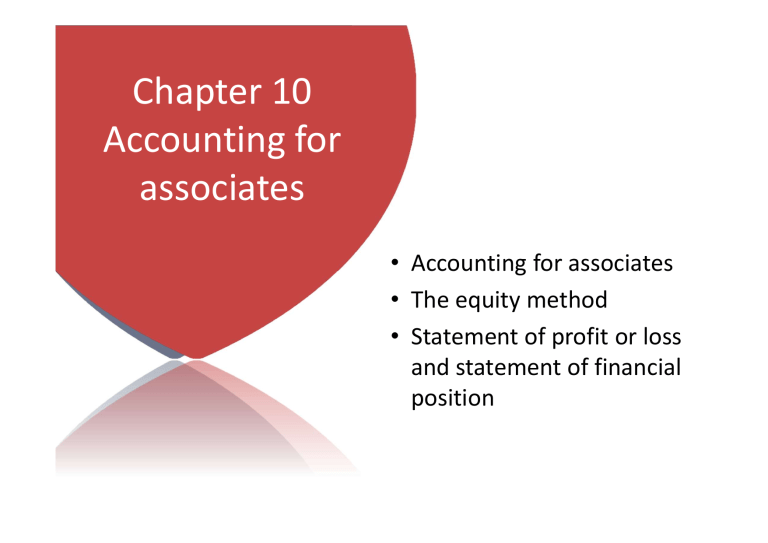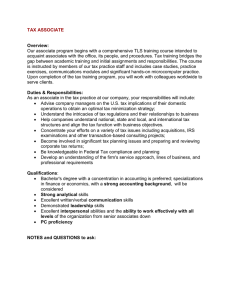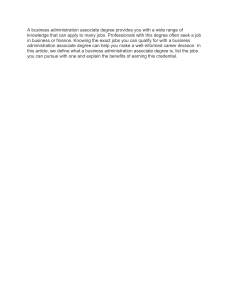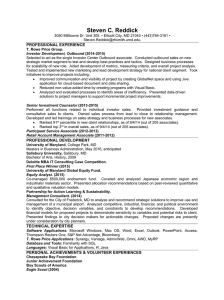
Chapter 10 Accounting for associates • Accounting for associates • The equity method • Statement of profit or loss and statement of financial position Chapter summary diagram Accounting for associates Definition Significant influence Accounting treatment Consolidated financial statements Accounting for associates Definition (IAS 28) • An associate is an entity over which the investor has significant influence. • Where significant influence is the power to participate in the financial and operating decisions of the investee but is not control or joint control over those policies. Accounting for associates • In the exam you should apply the '20% rule'. • If an investor holds, directly or indirectly, ≥ 20% of the voting power it is presumed that the investor has significant influence. Therefore the investment is presumed to be an associate unless it can be demonstrated otherwise. • Conversely, if an investor holds, directly or indirectly < 20% of the voting power it is presumed that the investor does not have significant influence. Therefore the investment is not presumed to be an associate unless it can be demonstrated otherwise. Accounting for associates • IAS 28 also states that significant influence can be shown by: – Representation on the board of directors – Participation in policy making processes – Material transactions between the investor and the investee – Interchange of managerial personnel – Provision of essential technical information Accounting for associates Investor's separate financial statements • Just as with the subsidiary, the investor can record the investment in the investee in its separate financial statements either: – At cost; or – At fair value IFRS 9 – Financial instruments – Equity method IAS 28 Consolidated financial statements Equity method The equity method • An investment in an associate is accounted for in the consolidated financial statements using the equity method. CONSOLIDATED STATEMENT OF FINANCIAL POSITION Non-current assets Investment in associate (Working) X Working Cost of associate Share of post-acquisition retained reserves Less impairment losses on associate to date X X/(X) (X) X The equity method CONSOLIDATED STATEMENT OF PROFIT OR LOSS AND OTHER COMPREHENSIVE INCOME Profit or loss A's Profit for the year × Group % X Shown before group profit before tax Other comprehensive income A's OCI x Group % X Note. In order to be able to account for an associate using the equity method a parent must already be producing consolidated accounts, ie it must have at least one subsidiary. The equity method Points to note • The associate is not a group company and so no cancellation of 'intragroup' transactions is performed. • However, to avoid double counting, the investor's share of unrealised profits and losses on transactions between the investor and the associate are eliminated in the same way as for group accounts. • The adjustments are (if the sale is by the associate): – DEBIT Gr share of A’s PFTY * /Group retained earnings (P's colum) – CREDIT Group inventories** * The convention is to increase (Dr) the cost of sales of the seller and so when we DEBIT Cost of sales of A we actually debit the share of associate's profit line. ** Another approach to upstream transaction when A sold goods to P is to CREDIT Investment in A Dr Gr RE Cr Investment in Associate The equity method Points to note (continued) • The adjustments are (if the sale is by the parent): – DEBIT Cost of sales of P/group retained earnings (P's column) – CREDIT Investment in associate* *Here, we credit the investment in associate rather than group inventories because A holds the inventories • The value of the adjustment at all times is the group percentage of the unrealised profit amount. So if there was a 30% associate and the unrealised profit was $100 the adjustment would be: – PUP × A%, ie $100 × 30% = $30 Question: Lecture example 1 At 31 December 20X4 the statements of financial position of Portus, Sanus and Allus were as follows. Portus Non-current assets Property, plant and equipment Investment in Sanus (at cost) Current assets Inventories Trade receivables Cash Equity Share capital ($1 shares) Reserves Non-current liabilities Long-term borrowings Current liabilities Trade and other payables Sanus Allus $'000 $'000 $'000 56,600 13,800 70,400 16,200 – 16,200 16,100 – 16,100 2,900 3,300 1,700 7,900 78,300 1,200 1,100 100 2,400 18,600 500 1,100 300 1,900 18,000 8,000 54,100 62,100 2,400 10,600 13,000 2,800 9,200 12,000 13,200 4,800 5,100 3,000 78,300 800 18,600 900 18,000 Question: Lecture example 1 (continued) Notes 1 On 1 April 20X4 Portus purchased a 80% holding in Sanus for $13.8 in cash. Sanus' total comprehensive income for the year ended 31 December 20X4 was $2.0m, accruing evenly over the year. Sanus did not pay any dividends in the year. Portus also acquired a 30% holding in Allus on 1 July 20X4 for 500,000 of its own shares. The stock market value of Portus' shares at the date of this share exchange was $9.40 each. Portus has not yet recorded the investment in Allus. Allus' reserves were $8.6m on 1 July 20X4. Question: Lecture example 1 (continued) 2 3 At the date of acquisition, the fair value of Sanus' assets were equal to their carrying amounts with the exception of the items listed below which exceeded their carrying amounts as follows. $'000 Inventories 300 Plant and equipment (ten-year remaining useful life) 1,200 1,500 Sanus has not adjusted the carrying amounts as a result of the fair value exercise. The inventories were sold by Sanus before the year end. The non-controlling interest in Sanus is to be valued at its fair value of $3.2m at the date of acquisition. An impairment test conducted at the year end revealed that the consolidated goodwill of Sanus was impaired by $150,000. Additionally, an impairment loss of $40,000 is to be recognised in respect of Portus' investment in Allus in the group financial statements. Question: Lecture example 1 (continued) 4 On 1 October 20X4, Sanus sold goods to Portus for $200,000 at a gross profit margin of 40%. The goods were still in Portus' inventories at the year end. No other sales were made between Portus and Sanus in the year. At 31 December 20X4 Portus' current account with Sanus was $130,000 (credit). This did not agree with the equivalent balance in Sanus' books due to cash in transit of $70,000 which was not received by Sanus until after the year end. After the acquisition, Allus sold goods to Portus for $400,000 at a mark-up on cost of 25%. A quarter of these goods remained in Portus' inventories at the year end. Required Prepare the consolidated statement of financial position of the Portus Group as at 31 December 20X4. Question: Lecture example 2 Continuing from Lecture example 1 and the previous chapter, the statements of profit or loss and other comprehensive income of Portus, its subsidiary Sanus and its associate Allus for the year ended 31 December 20X4 are as follows. Revenue Cost of sales Gross profit Expenses Finance costs Dividend income from Allus Profit before tax Income tax expense PROFIT FOR THE YEAR Other comprehensive income: Gains on property revaluation TOTAL COMPREHENSIVE INCOME FOR THE YEAR Portus $'000 28,500 (17,100) 11,400 (4,400) (400) 60 6,660 (2,100) 4,560 Sanus $'000 11,800 (7,000) 4,800 (2,200) (200) Allus $'000 9,500 (5,800) 3,700 (1,600) (200) 2,400 (800) 1,600 1,900 (600) 1,300 900 400 300 5,460 2,000 1,600 Question: Lecture example 2 (continued) Required Prepare the consolidated statement of profit or loss and other comprehensive income for the Portus Group for the year ended 31 December 20X4.



